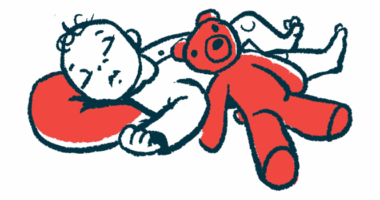Immune Response to Zolgensma Can Be Common in Older SMA Children

Abnormal increases in liver enzymes levels — suggestive of liver damage — and drops in platelet counts are common among spinal muscular atrophy (SMA) patients over 8 months old following treatment with Zolgensma, according to a small real-world study in Germany.
These side effects, which can be severe in some cases, are likely associated with a recognized immune reaction to the modified adeno-associated virus (AAV) used to deliver a working version of SMN1, the mutated gene in SMA, to cells in this gene therapy.
Notably, 8 months was the upper age limit of SMA patients enrolled in clinical trials supporting Zolgensma’s approval.
“[O]ur experience with eight patients older than eight months adds important findings to the increasing body of evidence that treatment of SMA with [Zolgensma] is often associated with an immune response against the AAV vector,” Janbernd Kirschner, MD, the study’s senior author with the department of neuropediatrics at University Hospital Bonn, said in a press release.
“However, it was possible to control the immune response in all patients by proactive monitoring and adapting the [immunosuppressive] steroid dose, and we did not detect any long-term side effects due to the immune response,” Kirschner added.
Further studies are needed to better understand the immune response against this gene therapy and to identify risk factors for a more severe reaction, the researchers noted.
The study, “Safety Monitoring of Gene Therapy for Spinal Muscular Atrophy with Onasemnogene Abeparvovec – A Single Centre Experience,” was published in the Journal of Neuromuscular Diseases.
Administered directly into the bloodstream at a dose proportional to a patient’s body weight, Zolgensma — marketed by Novartis — can only be given once due to the body’s natural immune response against the modified AAV used to deliver the SMN1 gene.
Still, patients can develop immune reactions after the single dose, which may raise the levels of liver enzymes — an indicator of liver damage — and drop the levels of platelets.
For that reason, a prednisolone course for immunosuppression should be started on the day before treatment, with liver function and platelet counts monitored before treatment, and at regular periods thereafter.
Notably, while the therapy is available to SMA patients up to age 2 in the U.S. and in other countries, and up to about 5 years old in Europe, Zolgensma’s clinical trials mostly involved infants up to 8 months old.
Safety concerns due to these broader labels exist for older and heavier patients, as higher doses with higher number of viral carriers can lead to more pronounced side effects. Real-world data on Zolgensma’s use in older SMA patients are, for this reason, key to better understanding the therapy’s safety profile across its approved patient population.
Researchers in Germany describe early safety findings from eight children (four boys and four girls) who received a single dose of Zolgensma at ages beyond 8 months between December 2019 and September 2020 at their university hospital.
At the time of treatment, the children ranged in age between 10 months and 37 months (about 3 years old) and weighed 7.1 to 11.9 kilograms (about 16 to 26 lbs). All carried two or three copies of the “backup” SMN2 gene, which influences disease severity, and all had been previously treated with Spinraza, the first approved SMA disease-modifying therapy.
The children were switched to gene therapy “with the hope to see additional benefit and to avoid repetitive lumbar punctures,” the researchers wrote.
As recommended, all were given prednisolone for four weeks starting on the day before gene therapy. Their post-treatment follow-up ranged from two to 11 months.
Results showed that following Zolgensma, all children had a temporary raise in body temperature and an increase in liver enzymes levels, which was associated with impaired liver function in one child. This severe response was successfully managed with a higher dose of steroid therapy given daily for five days.
Six children also showed abnormally low platelet counts, but with no signs of bleeding. Levels of monocytes, a type of immune cell involved in the fight against infections, were also increased in seven children.
Four children showed abnormally high levels of the troponin I protein — which can indicate heart damage — after treatment, but this was not associated with any clinical symptoms or heart abnormalities.
Most of these clinical and laboratory abnormalities occurred or were more pronounced in the first week after treatment, and resolved during the observation period.
In all but one patient, the standard dose of prednisolone was increased and/or prolonged beyond the minimum four weeks recommended.
The rate of these adverse events was higher than that reported in Zolgensma’s pivotal trial, the team noted, suggesting and this may be due to age and body weight differences.
These findings are consistent with those previously reported by a real-world study in Ohio, which showed that older patients have a higher risk of liver injury, and may need longer immunosuppressive treatment.
“It is premature to judge whether severe organ damage with long-term consequences can always be avoided,” Kirschner said, adding that “further research is needed to better understand the immune response following gene therapy and ideally to identify patients at risk for a more severe reaction.
“Total viral vector dose and thus body weight is most likely one aspect, but there might be other [patient-dependent] factors that are more difficult to identify,” the researchers wrote.
.pf-button.pf-button-excerpt { display: none; }
The post Immune Response to Zolgensma Can Be Common in Older SMA Children appeared first on SMA News Today.



